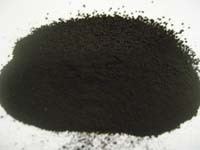Formula Mn2O3 Melting point 940 °C | Molar mass 157.8743 g/mol Density 4.5 g/cm³ | |
 | ||
Related compounds Appearance brown or black crystalline | ||
Manganese(III) oxide is a chemical compound with the formula Mn2O3.
Contents
Preparation and chemistry
Heating MnO2 in air at below 800 °C α-Mn2O3 is produced (higher temperatures produce Mn3O4). γ-Mn2O3 can be produced by oxidation followed by dehydration of manganese(II) hydroxide. Many preparations of nano-crystalline Mn2O3 have been reported, for example syntheses involving oxidation of MnII salts or reduction of MnO2.
Manganese (III) oxide is formed by the redox reaction in an alkaline cell:
2 MnO2 + Zn → Mn2O3 + ZnOManganese (III) oxide Mn2O3 must not be confused with MnOOH manganese (III) oxyhydroxide. Contrary to Mn2O3, MnOOH is a compound that decomposes at about 300 °C to form MnO2.
Structure
Mn2O3 is unlike many other transition metal oxides in that it does not adopt the corundum (Al2O3) structure. Two forms are generally recognized, α-Mn2O3 and γ-Mn2O3, although a high pressure form with the CaIrO3 structure has been reported too.
α-Mn2O3 has the cubic bixbyite structure, which is an example of a C-type rare earth sesquioxide (Pearson symbol cI80, space group Ia3, #206). The bixbyite structure has been found to be stabilised by the presence of small amounts of Fe3+, pure Mn2O3 has an orthorhombic structure (Pearson symbol oP24,space group Pbca, #61).
γ-Mn2O3 has a structure related to the spinel structure of Mn3O4 where the oxide ions are cubic close packed. This is similar to the relationship between γ-Fe2O3 and Fe3O4. γ-Mn2O3 is ferrimagnetic with a Néel temperature of 39 K.
